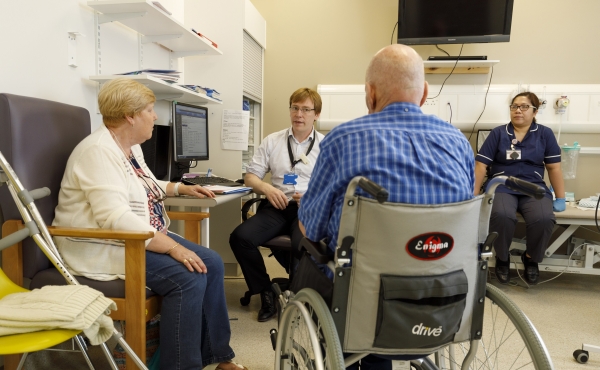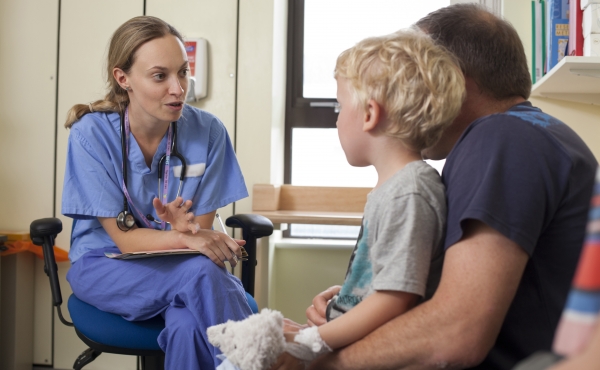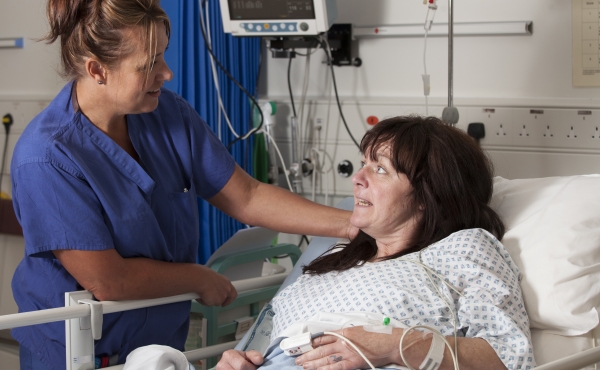Case Study: Streamlining the elective surgical HDU pathway
Dr Rukinder Kaur Birk Consultant Anaesthesia & Intensive Care Medicine, Medical lead for Pre-assessment Service Case Study: Streamlining the elective surgical HDU pathway Overall Summary Brief summary of problem, solution, key results and outcomes of the case study In 2022 we recognised that there was pressure being put onto the ITU capacity in our 10-bedded, general medical and surgical, combined ITU/HDU. This was a combination of the COVID pandemic and the new robotic service which was being trialled for colorectal sugery. There was a need to streamline the pathway to ensure that the beds were being used efficiently whilst maintaining high standards of care and patient safety. We, therefore, conducted a quality improvement project with the aim to increase the proportion of planned ITU admissions and reduce the proportion of avoidable, unplanned ITU admissions requiring Level 2 or 3 support relative to all ITU patients admitted through the elective pathway. We retrospectively collected baseline data from 2021 on all ITU admissions which came through the elective surgical pathway, in order to identify potential ways of identifying those patients who were more likely to require Level 2 or 3 support. The data analysis suggested that a SORT score of approximately 5 or more seemed to be able to identify these high-risk patients. Through a multi-disciplinary discussion between ITU and Pre-operative assessment (POA) we planned to study the effect of using a SORT score of 5 or more to assess the effect on our aforementioned aim. At the time we encouraged anaesthetists in the POA clinic and Theatres to use the SORT score as a guide to referring patients to ICU post-operatively and produced a poster on this as a reminder in the POA clinic room. We recently repeated the data analysis to assess whether these changes were making a difference, on patients who had elective surgery in 2024. The results show that, although there have been no adverse incidents since making the changes, there is still some work to be done with regards to improving the use of the SORT score in POA clinics, given the lack of decrease in avoidable, unplanned ICU admissions. One of the suggested areas for improvement is increased education of POA nursing staff to escalate high-risk patients appropriately to anaesthetists, who can then advise on clinical management and ICU admission. We have done this through face-to-face training and have also devised an algorithm which could assist nursing staff in selecting high-risk patients for review by an anaesthetist. We have also written and implemented guidelines on identification and management of conditions, such as diabetes and anaemia. We have presented our findings to the anaesthetic and ITU departments as well as the colorectal surgeons to ensure that there is a consistency in approach. More recently we have also included the SORT tool as part of a digital screening tool to be completed by surgeons at the time of booking patients for surgery. Additionally, we have added the SORT tool in our online anaesthetic review section as another visual reminder for the POA anaesthetist to complete this at the time of making a patient management plan. These measures should allow us to prospectively anticipate clinical need and staffing ahead of planned surgery and to ultimately streamline the elective ITU pathway to meet our aim and to ensure that there were no adverse effects of introducing this change, specifically, an increase in 30-day post-operative mortality of patients not admitted to ITU directly from Theatres. |
Describe the problem
| In 2022 we recognised that there was pressure being put onto the ITU capacity in our 10-bedded, general medical and surgical, combined ITU/HDU. This was a combination of the COVID pandemic and the new robotic service which was being trialled for colorectal surgery. There was a need to streamline the pathway to ensure that the beds were being used efficiently whilst maintaining high standards of care and patient safety. We, therefore, conducted a quality improvement project with the aim to increase the proportion of planned ITU admissions and reduce the proportion of avoidable, unplanned ITU admissions requiring Level 2 or 3 support relative to all patients admitted to ITU through the elective pathway. Success would be measured by a reduction in the number of unplanned ICU admissions as a proportion of all elective surgical cases requiring anaesthetic input. |
The number of patients affected
In 2021 there were 66 patients admitted to our combined ITU/HDU after elective surgery.
In 2024 there were 53 patients admitted to our combined ITU/HDU after elective surgery.
What solutions were identified?
We wanted to use a short, simple scoring system that would easily and quickly identify high-risk patients who would benefit from Level 2/3 care. We investigated the use of the SORT score and the Charlson Comorbidity Index in being able to predict the need for Level 2/3 support. The SORT score performed better.
Since the repeat data analysis from 2024 it became apparent that the SORT score was still not being used effectively and that further training and communication on this was necessary. We have presented our results to the anaesthetic and ITU departments as well as the colorectal surgeons, to ensure consistency of practice.
Another factor related to avoidable, unplanned ICU admission was recognition of the high-risk patient. To tackle this we arranged training for POA nursing staff on recognition of the high-risk patient who would require anaesthetic input through the use of face-to-face training and a bespoke algorithm to assist in escalation for anaesthetic review. A further development in August 2024 was the implementation of a new, digital screening tool, which includes the SORT tool, to be completed by surgeons at the time of booking patients for surgery, the idea being to identify the high-risk patient and escalate for anesthetic review early. Additionally, we have added the SORT tool and a section on need for post-operative ITU bed in our online anaesthetic review section as another visual reminder for the POA anaesthetist to complete this at the time of making a patient management plan.
Why and how were these solutions selected?
See above. The rationale for using these measures was to ensure that, as a department, we were aligned with the recommendations produced by NHS England (1), the RCOA GPAS standards (2) and the Royal College of Surgeons (3) in terms of early risk assessment and planning.
What were the challenges and enablers to success?
one challenge was finding a system of streamlining ITU admissions which would allow the Pre-assessment anaesthetist the flexibility to admit appropriate patients to ITU who may not have had a SORT score of 5 or more but were felt to be too high risk to be admitted to a surgical ward. It was decided that the Pre-assessment anaesthetist could still book an elective ITU bed using their clinical judgement in such cases. If the decision to admit is contentious or there was a lack of an ITU bed on the day of surgery, then a discussion could be had between the MDT as regards to the options of cancelling the case versus continuing and discharging patient to a surgical ward on the Level 1 pathway. The Level 1 pathway is our nurse-led Critical Care Outreach service which operates on a 24/7 basis. Also, the use of a mortality trigger of 5% for ITU escalation was challenged, but eventually agreed that this was in line with the NELA audit for emergency colorectal surgery as well as from national recommendations (3).
-the POA nursing staff were overall very open to having training and, in particular, welcomed the idea of an algorithm to assist in decision-making. However, as expected, there have been some teething issues with implementing the various guidelines we have put in place, partly because of lack of familiarity, in the first instance. We are continuing to identify and learn from any incidents and, through education and time, these will hopefully become embedded in practice.
-the surgical department were apprehensive of using the digital risk-assessment tool at the time of booking. However, it is being used and there is a separate project ongoing to assess its effectiveness.
Did the solution require a multi-disciplinary approach? If yes, which disciplines were involved?
Yes, there was multi-disciplinary input from the relevant stakeholders (anaesthetists, ITU staff- including admin staff, Pre-assessment nursing staff and the colorectal surgical team).
What evidence is there to demonstrate impact on:
- morbidity/mortality
- patient record outcomes
- patient experience
- process measures
Elective ITU/HDU bookings in 2021
Elective ITU/HDU Bookings in 2024
Summary of 2024 data: -53 patients in total were admitted to HDU/ITU post-op in 2024. This compares to 66 patients in total admitted to ICU in 2021 (18% reduction). Of these 33 were planned (62%), 20 were unplanned (38%). The vast majority of patients admitted had colorectal surgery (n= 33, 62%). -16 patients referred to ICU by POA were sent to a surgical ward post-operatively instead of ICU. 8 of these (50%) had SORT scores ≥ 5, one of whom died 3 months after surgery. Most of these referrals were “soft” referrals i.e dependent on how surgery went on the day, ITU bed could be booked but may not be necessary. None of the patients who were directly discharged to a surgical ward from Theatres required unplanned admission to ICU or died within 30 days of surgery. -Of all planned ICU admissions recommended by POA (n= 40), 60% were admitted to ICU. Of all planned ICU admissions recommended by surgeons (n= 48), 19% were admitted to ICU. -the number of unplanned ITU admissions have increased from 2021 (n= 12, 18%) to 2024 (n= 20, 38%). However, this is commensurate with an increase in Theatre throughput for elective surgery, including colorectal surgery. Specifically, in 2021 there were 10833 elective operations requiring anaesthetic input which increased to 15831 in 2024. -7 unplanned admissions (all colorectal) could have been planned admissions had the SORT score been used. This would have reduced unplanned admissions from n=20 to n=13. Two of these patients required Level 2/3 support. A further 4 unplanned admissions were unpredictable (see below, 2 patients had unexpected anaphylaxis, one had a rare surgical complication and another an unexpected difficult airway). -5 patients reviewed by the POA nursing staff should have been escalated to the POA anaesthetist, either because of the SORT score (n=3) or due to other diseases which required optimising (n=2). This could have potentially led to a further 2 avoidable ICU admissions. -15 patients needed Level 2/3 support (28% of all elective ICU admissions), similar to 2021 (23% of all elective ICU admissions). However, 80% of those patients requiring Level 2/3 support were planned ITU admissions in 2021 compared to 27% in 2024. - reasons for needing Level 2/3 support: predictable: a)hypotension (n=2). Patients had SORT >5 b)post-ictal (n=1). c)difficult airway and hypoxia (n= 1). unpredictable: a)hypotension (n=7). One patient had anaphylaxis. Two patients had SORT >5 b)respiratory support (n=3). One patient had anaphylaxis. Another patient was high BMI and long urology op. Another had surgical complication. c)difficult airway and hypoxia in ASA 1, asymptomatic patient
| |||||||||||||||||||||||||||||||||||||||||||||||||||||||||||||||||||||||||||||||||||||||||||||||||||||||||||||||||||||||||||||||||||||||||||||||||||||||||||||||||||||||||||||||||||||||||||||||||||||||||||||||||||||
| |||||||||||||||||||||||||||||||||||||||||||||||||||||||||||||||||||||||||||||||||||||||||||||||||||||||||||||||||||||||||||||||||||||||||||||||||||||||||||||||||||||||||||||||||||||||||||||||||||||||||||||||||||||
Were patients engaged and consulted:
We didn’t consult patients in the decision to use a scoring system to facilitate decision-making to ITU placement after elective surgery. However, as is usual practice, we would normally communicate with individual patients who are identified as high-risk at the time of Pre-assessment where ITU admission is advised post-operatively.
To repeat the data analysis in 1-2 years to assess whether there has been any improvement in the number of unplanned ICU admissions.
1. NHS England (2023). Earlier screening, risk assessment and health optimisation in perioperative pathways: guide for providers and integraded care boards. Available at: https://www.england.nhs.uk/long-read/earlier-screening-risk-assessment-and-health-optimisation-in-perioperative-pathways/ (Accessed 23 Januay 2025)
2. Royal College of Anaesthetists (2024). Chapter 2: Guidelines for the Provision of Anaesthesia Services for the Perioperative Care of Elective and Urgent Care Patients. Available at: https://www.rcoa.ac.uk/sites/default/files/documents/2024-03/GPAS-2024-02-PERIOPCARE_VMar24_0.pdf (Accessed 23 January 2025)
3. Royal College of Surgeons (2018). The High-risk General Surgical Patient: Raising the Standard. Available at: https://www.rcseng.ac.uk/-/media/files/rcs/news-and-events/media-centre/2018-press-releases-documents/rcs-report-the-highrisk-general-surgical-patient--raising-the-standard--december-2018.pdf (Accessed at 23 January 2025)
Do you have an example of great perioperative care?
Please get in touch and submit a Case Study submission so we can share it with the world!




